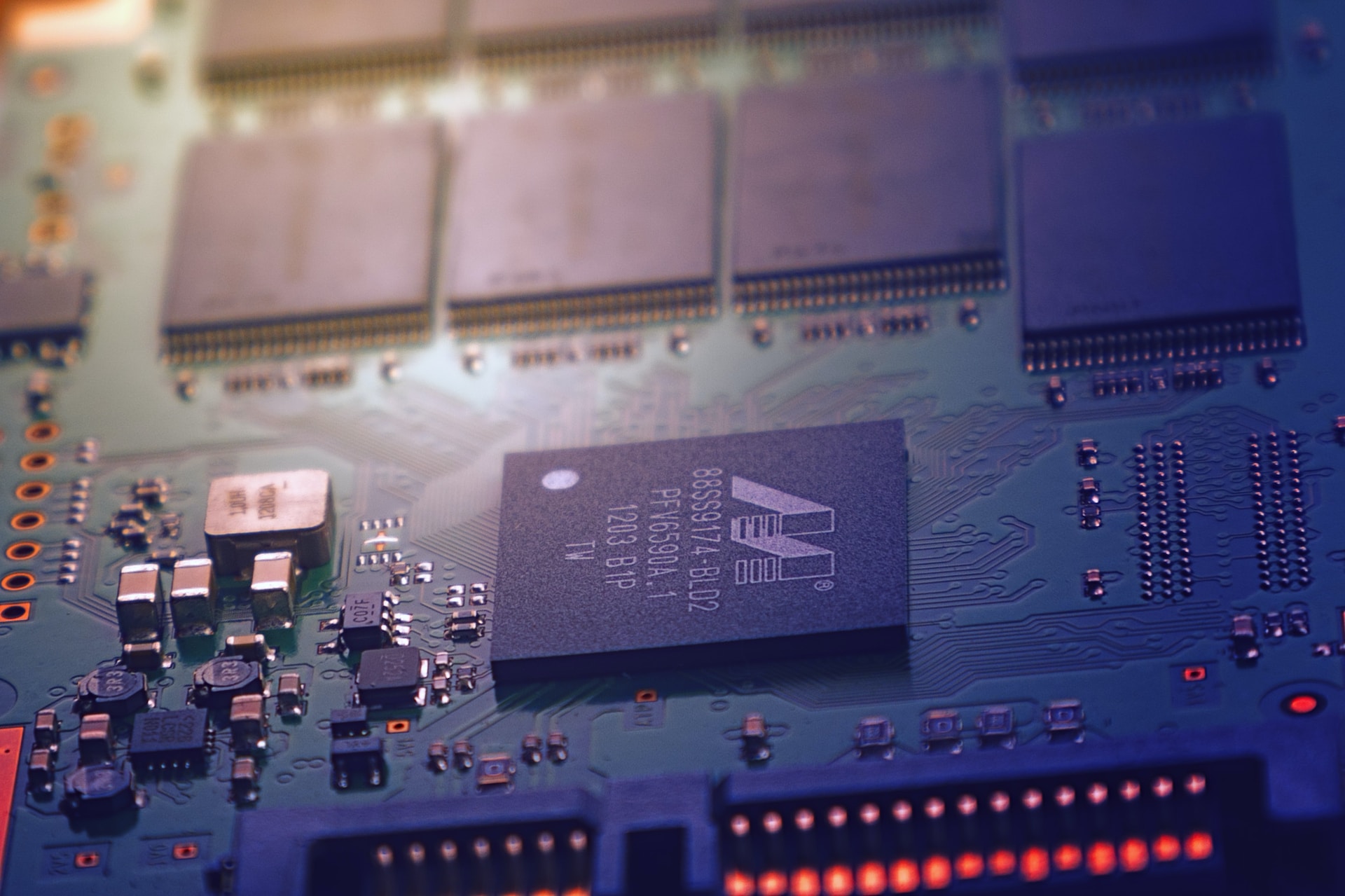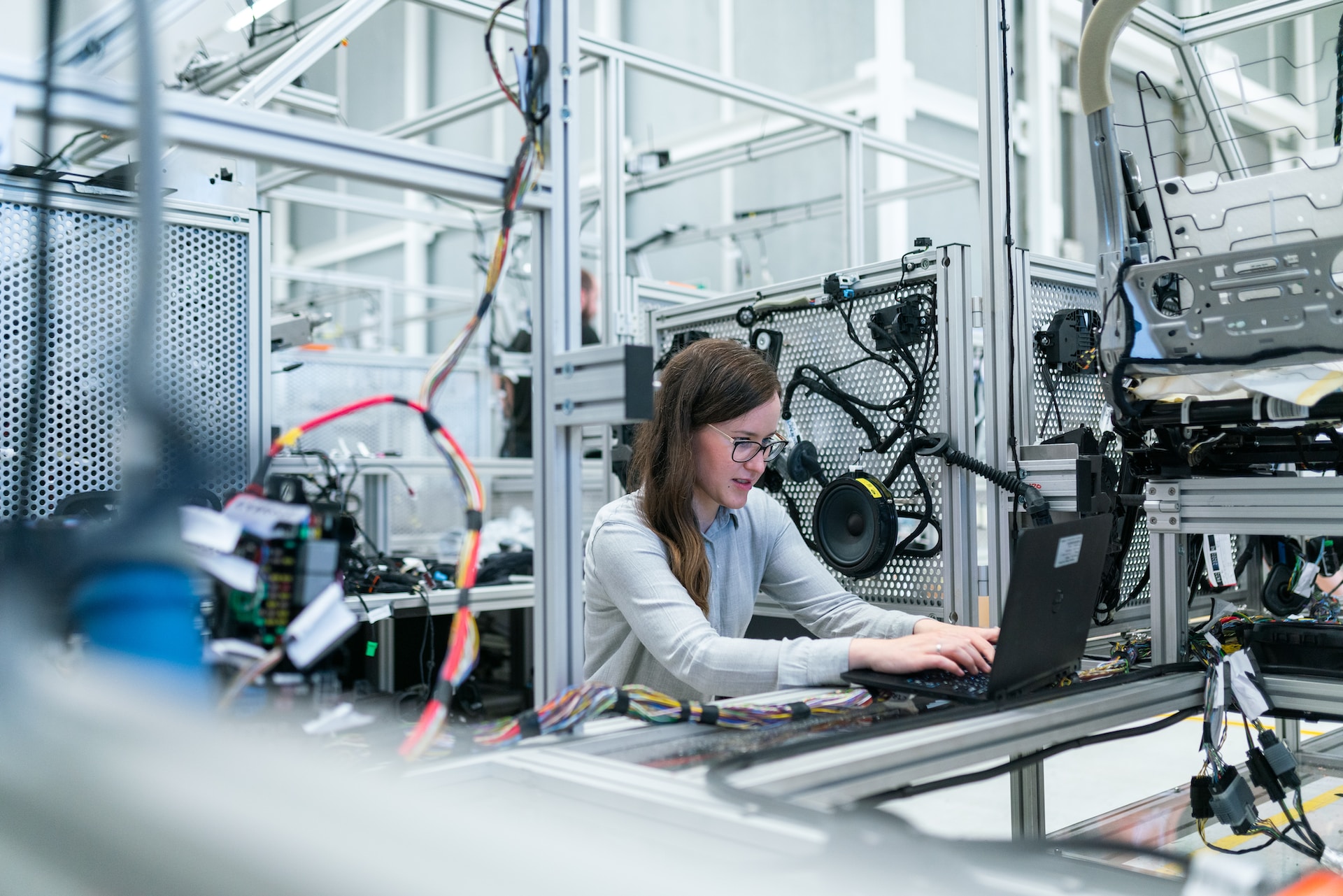The World Economic Forum and Frontiers Media S.A. have published their annual report on the Top 10 Emerging Technologies of 2023.
These are the technologies that have the most potential to positively impact society within the next three to five years, by addressing global challenges, creating new opportunities and improving our lives.
In this article, we will explore each of these technologies, their applications, benefits and risks, and some examples of how they are being used or developed around the world.
 Photo by Christina @ wocintechchat.com on Unsplash
Photo by Christina @ wocintechchat.com on Unsplash
Emerging Technologies of 2023 – The Top 10 Overview
- Flexible Batteries: These are thin, lightweight batteries that can be twisted, bent and stretched without losing their performance. They can power wearable devices, medical implants, smart clothing and more.
- Generative Artificial Intelligence: This is a type of AI that can create original content, such as images, music, text, code and more. It can be used for entertainment, education, research and innovation.
- Sustainable Aviation Fuel: This is a low-carbon alternative to conventional jet fuel that can reduce greenhouse gas emissions from air travel. It can be made from renewable sources, such as waste oils, biomass and synthetic gases.
- Designer Phages: These are engineered viruses that can target and kill specific bacteria, without harming other cells or the microbiome. They can be used to treat antibiotic-resistant infections, modulate the immune system and deliver gene therapies.
- Metaverse for Mental Health: This is a virtual shared space that can provide mental health support and therapy to people who are isolated, stressed or depressed. It can offer immersive experiences, social interactions and personalized feedback.
Amazing, isn’t it? Yet, there’s more!
- Wearable Plant Sensors: These are tiny sensors that can be attached to plants and measure their physiological signals, such as water stress, nutrient deficiency and disease. They can help farmers optimize crop production, reduce water use and prevent losses.
- Spatial Omics: This is a technique that can map the molecular composition of tissues and organs at high resolution. It can reveal how genes, proteins and metabolites interact in different locations and conditions. It can advance our understanding of health and disease.
- Flexible Neural Electronics: These are soft, stretchable circuits that can interface with the brain and nervous system. They can record and stimulate neural activity, monitor vital signs and deliver drugs. They can enable new therapies for neurological disorders, chronic pain and spinal cord injuries.
- Digital Twins: These are virtual replicas of physical objects, systems or processes that can simulate their behavior and performance under different scenarios. They can help optimize design, operation and maintenance of complex systems, such as buildings, factories and cities.
- Quantum Machine Learning: This is a branch of machine learning that leverages quantum computing to enhance data analysis, optimization and learning. It can solve problems that are intractable for classical computers, such as finding patterns in large datasets, optimizing complex functions and generating novel solutions.
Now, let’s dive in and explore these emerging technologies in more details.
 Photo by Johannes Plenio on Unsplash
Photo by Johannes Plenio on Unsplash
Emerging Technologies of 2023 – The Top 10 in Details
Flexible Batteries
Standard rigid batteries may soon be a thing of the past, as thin, flexible batteries – made of lightweight materials that can be twisted, bent and stretched – reach the market. These batteries can power wearable devices, medical implants, smart clothing and more, without compromising their performance or safety.
Flexible batteries can enable new forms of human-machine interaction, such as smart tattoos, skin patches and contact lenses. They can also improve the comfort and convenience of existing devices, such as hearing aids, pacemakers and fitness trackers. Moreover, they can reduce the environmental impact of battery disposal, as they can be easily recycled or biodegraded.
One example of a flexible battery is the zinc-air battery developed by researchers at the University of Cambridge. This battery can be printed on any surface, such as paper or fabric, and can be recharged by simply replacing the zinc ink. It can power low-cost sensors and devices for healthcare, environmental monitoring and smart packaging.
Another example is the stretchable lithium-ion battery developed by researchers at Stanford University. This battery can stretch up to 300% of its original size, while maintaining its capacity and voltage. It can power wearable electronics that conform to the shape and movement of the human body, such as smart gloves, bandages and prosthetics.
Generative Artificial Intelligence
Artificial intelligence (AI) is not only capable of analyzing data and performing tasks, but also of creating original content, such as images, music, text, code and more. This type of AI is called generative AI, and it uses algorithms that learn from data and generate new outputs that are similar but not identical to the inputs.
Generative AI can be used for entertainment, education, research and innovation. It can create realistic and diverse content that can inspire human creativity, such as art, games, stories and songs. It can also generate synthetic data that can augment existing datasets or replace sensitive data for privacy purposes. Furthermore, it can produce novel solutions that can solve complex problems or optimize existing systems.
One example of generative AI is GPT-3, a language model developed by OpenAI. GPT-3 can generate coherent and fluent text on any topic, given a few words or sentences as input. It can write essays, summaries, stories, lyrics, code and more. It can also answer questions, converse with humans and perform tasks.
Another example is DALL-E, an image generator developed by OpenAI. DALL-E can create realistic and imaginative images from text descriptions, such as “a snail made of a harp” or “a store front that has the word ‘openai’ written on it”. It can also manipulate existing images based on text instructions, such as “the same cat on a blue background” or “the same house with two chimneys”.
Sustainable Aviation Fuel
The aviation industry generates between 2-3% of global CO2 emissions, but all regions of the world are set to see big increases by 2050. Unlike many other industries, the weight-to-power ratio of batteries makes electrification a challenge. That’s where sustainable aviation fuel (SAF) comes in.
SAF is a low-carbon alternative to conventional jet fuel that can reduce greenhouse gas emissions from air travel. It can be made from renewable sources, such as waste oils, biomass and synthetic gases. It can also be blended with fossil fuels and used in existing aircraft engines and infrastructure, without requiring major modifications.
SAF can help the aviation industry meet its climate goals, while also creating new jobs and markets for green energy. It can also improve air quality and reduce noise pollution around airports. However, SAF faces some challenges, such as high costs, limited supply and regulatory barriers.
One example of SAF is the biofuel produced by Neste, a Finnish company. Neste’s biofuel is made from waste and residue raw materials, such as used cooking oil and animal fat. It can reduce greenhouse gas emissions by up to 80% compared to fossil fuels. Neste’s biofuel is already used by several airlines, such as Lufthansa, KLM and American Airlines.
Another example is the synthetic fuel produced by Carbon Engineering, a Canadian company. Carbon Engineering’s synthetic fuel is made from carbon dioxide captured from the air and hydrogen produced from water using renewable electricity. It can reduce greenhouse gas emissions by up to 100% compared to fossil fuels. Carbon Engineering’s synthetic fuel is expected to be commercially available by 2025.
Designer Phages
Bacteria are becoming increasingly resistant to antibiotics, posing a serious threat to human health and wellbeing. One possible solution is to use viruses that infect and kill bacteria, called phages. Phages are abundant in nature and have been used for decades to treat bacterial infections in some countries. However, they have some limitations, such as specificity, stability and immunity.
Designer phages are engineered viruses that can overcome these limitations and target specific bacteria, without harming other cells or the microbiome. They can be modified to enhance their efficacy, stability and safety. They can also be used to treat antibiotic-resistant infections, modulate the immune system and deliver gene therapies.
Designer phages can offer a new way of fighting bacterial diseases, while also reducing the reliance on antibiotics and preventing their misuse. They can also enable personalized medicine, as they can be tailored to individual patients and infections. However, designer phages also pose some risks, such as unintended consequences, ethical issues and bioterrorism.
One example of designer phages is the phage therapy developed by Adaptive Phage Therapeutics (APT), a US company. APT’s phage therapy uses a library of natural phages that can be rapidly screened and matched to the patient’s infection. APT’s phage therapy has been successfully used to treat several cases of life-threatening infections that were resistant to antibiotics.
Another example is the CRISPR-Cas3 phage developed by researchers at UC San Diego. CRISPR-Cas3 is a gene-editing tool that can cut and destroy large segments of DNA in bacteria. The researchers used CRISPR-Cas3 to modify a phage that can target and kill E. coli bacteria, while leaving other bacteria intact. The CRISPR-Cas3 phage could potentially be used to treat urinary tract infections and other diseases caused by E. coli.
Metaverse for Mental Health
The COVID-19 pandemic has increased the levels of stress, anxiety and depression among people around the world. Many people have faced isolation, loneliness and loss of social support during the lockdowns and social distancing measures. One possible way of coping with these challenges is to use virtual reality (VR) to create a metaverse for mental health.
A metaverse is a virtual shared space that can provide mental health support and therapy to people who are isolated, stressed or depressed. It can offer immersive experiences, social interactions and personalized feedback that can enhance well-being, resilience and recovery. It can also provide access to mental health services that may be otherwise unavailable or unaffordable.
A metaverse for mental health can help people cope with their emotions, connect with others and find meaning in their lives. It can also reduce stigma and discrimination associated with mental health issues. However, a metaverse for mental health also has some drawbacks, such as addiction, privacy and safety concerns.
One example of a metaverse for mental health is Healium XR, a VR platform developed by StoryUP Studios, a US company. Healium XR uses biometric feedback from wearable devices to create immersive environments that respond to the user’s emotions. Healium XR can help users reduce stress, anxiety and negative thoughts, and increase positive emotions, mindfulness and self-compassion.
Another example is VRChat, a VR social platform that allows users to create and explore virtual worlds with other users. VRChat has been used by some users to form support groups and communities for mental health issues, such as depression, anxiety and PTSD. VRChat can help users express themselves, make friends and find support in a safe and inclusive space.
Wearable Plant Sensors
Plants are vital for our food security, biodiversity and climate regulation. However, they are also vulnerable to various stresses, such as drought, pests and diseases. To monitor and optimize plant health and productivity, farmers and researchers need to measure their physiological signals, such as water stress, nutrient deficiency and disease.
Wearable plant sensors are tiny sensors that can be attached to plants and measure their physiological signals in real time. They can transmit the data wirelessly to a smartphone or a cloud platform, where it can be analyzed and visualized. They can help farmers optimize crop production, reduce water use and prevent losses. Also, they can help researchers understand plant biology and ecology.
Wearable plant sensors can enable precision agriculture, which can increase crop yields, quality and profitability, while also reducing environmental impacts. They can also enable plant phenotyping, which can accelerate plant breeding and genetic improvement. However, wearable plant sensors also face some challenges, such as scalability, durability and compatibility.
One example of a wearable plant sensor is the FloraPulse sensor developed by FloraPulse Inc., a US company. The FloraPulse sensor is a microchip that can be inserted into the stem of a plant and measure its water potential, which indicates its water status and needs. The FloraPulse sensor can help farmers optimize irrigation and save water and energy.
Another example is the Leaf Clip sensor developed by researchers at the University of Illinois. The Leaf Clip sensor is a clip that can be attached to the leaf of a plant and measure its fluorescence, which indicates its photosynthesis and stress levels. The Leaf Clip sensor can help researchers study plant responses to environmental changes and identify traits for crop improvement.
Spatial Omics
The human body is composed of trillions of cells that work together to perform various functions. To understand how these cells interact and cooperate, we need to map their molecular composition and activity at high resolution. This is the goal of spatial omics, a technique that can reveal how genes, proteins and metabolites interact in different locations and conditions.
Spatial omics combines microscopy, sequencing and mass spectrometry to capture the spatial distribution and expression of molecules in tissues and organs. It can provide a holistic view of the molecular landscape and dynamics of the human body. It can advance our understanding of health and disease, such as cancer, neurodegeneration and inflammation.
Spatial omics can enable new discoveries and applications in biomedical research and medicine. It can help identify biomarkers for diagnosis, prognosis and treatment. It can also help design targeted therapies that can modulate specific cells or regions. However, spatial omics also requires high-throughput, high-resolution and high-accuracy technologies that are still under development.
One example of spatial omics is the 10x Genomics Visium platform developed by 10x Genomics Inc., a US company. The Visium platform is a system that can capture the spatial transcriptome of tissues, which is the expression of genes in different locations. The Visium platform can help researchers explore tissue architecture, cell types and functions.
Another example is the NanoString GeoMx platform developed by NanoString Technologies Inc., a US company. The GeoMx platform is a system that can capture the spatial proteome of tissues, which is the expression of proteins in different locations. The GeoMx platform can help researchers investigate tissue heterogeneity, pathways and interactions.
Flexible Neural Electronics
The brain and nervous system are responsible for controlling our thoughts, emotions, sensations and actions. To understand how they work and how they malfunction, we need to interface with them using devices that can record and stimulate neural activity. However, most existing devices are rigid, bulky and invasive, which limit their functionality and compatibility.
Flexible neural electronics are soft, stretchable circuits that can interface with the brain and nervous system. They can conform to the shape and movement of neural tissues, without causing damage or inflammation. They can record and stimulate neural activity with high resolution and sensitivity. Also, they can monitor vital signs and deliver drugs.
Flexible neural electronics can enable new therapies for neurological disorders, chronic pain and spinal cord injuries. They can also enable new applications in brain-computer interfaces, neuroprosthetics and neuromodulation. However, flexible neural electronics also pose some challenges, such as biocompatibility, durability and wireless communication.
One example of flexible neural electronics is the Neural Matrix device developed by researchers at Northwestern University. The Neural Matrix device is a mesh-like implant that can wrap around the spinal cord and record its electrical signals. The Neural Matrix device can help restore motor function in patients with spinal cord injuries.
Another example is the Neuralink device developed by Neuralink Corp., a US company founded by Elon Musk. The Neuralink device is a coin-sized implant that can connect to thousands of electrodes inserted into the brain using thin wires. The Neuralink device can help treat neurological diseases such as Parkinson’s disease, epilepsy and Alzheimer’s disease.
Digital Twins
The physical world is becoming increasingly connected and complex, as more objects, systems and processes are embedded with sensors, actuators and software. To manage and optimize these systems, we need to create virtual replicas of them that can simulate their behavior and performance under different scenarios. These replicas are called digital twins.
Digital twins are dynamic models that can mirror the state and condition of their physical counterparts in real time. They can integrate data from multiple sources, such as sensors, databases and simulations. They can enable interaction and feedback between the physical and digital domains. Also, they can help optimize design, operation and maintenance of complex systems, such as buildings, factories and cities.
Digital twins can offer many benefits, such as improved efficiency, productivity and quality, reduced costs, risks and errors, enhanced innovation and sustainability. They can also enable new services and business models, such as predictive analytics, remote monitoring and control, and personalized experiences. However, digital twins also require high computing power, data security and interoperability.
One example of digital twins is the Cityzenith platform developed by Cityzenith Inc., a US company. The Cityzenith platform is a software that can create digital twins of cities and urban projects. The Cityzenith platform can help city planners, developers and managers visualize, analyze and optimize urban development and performance.
Another example is the Siemens Digital Enterprise platform developed by Siemens AG, a German company. The Siemens Digital Enterprise platform is a software that can create digital twins of industrial systems and processes. The Siemens Digital Enterprise platform can help manufacturers design, simulate and test products and production lines.
Quantum Machine Learning
Machine learning is a branch of artificial intelligence that uses algorithms to learn from data and perform tasks, such as classification, regression, clustering and generation. Machine learning can solve many problems that are intractable for classical computers, such as finding patterns in large datasets, optimizing complex functions and generating novel solutions. However, machine learning also faces some limitations, such as scalability, accuracy and speed.
Quantum machine learning is a branch of machine learning that leverages quantum computing to enhance data analysis, optimization and learning. Quantum computing uses quantum bits or qubits that can exist in superposition of two states, 0 and 1, and entanglement of multiple qubits. Such computing can perform parallel computations and exploit quantum phenomena to solve problems faster or better than classical computers.
Quantum machine learning can offer many advantages, such as improved performance, scalability and robustness, reduced complexity and resource consumption, enhanced creativity and diversity. It can also enable new applications in fields such as chemistry, physics, biology and cryptography. However, quantum machine learning also faces some challenges, such as hardware limitations, algorithm design and validation.
One example of quantum machine learning is the Qiskit Machine Learning framework developed by IBM Research. The Qiskit Machine Learning framework is a software that can run machine learning algorithms on quantum computers or simulators. The Qiskit Machine Learning framework can help researchers explore quantum-enhanced machine learning models and applications.
Another example is the TensorFlow Quantum library developed by Google AI Quantum. The TensorFlow Quantum library is a software that can integrate quantum computing with TensorFlow, a popular machine learning platform. The TensorFlow Quantum library can help developers build and train quantum machine learning models using hybrid quantum-classical neural networks.
 Photo by ThisisEngineering RAEng on Unsplash
Photo by ThisisEngineering RAEng on Unsplash
Conclusion
The Top 10 Emerging Technologies of 2023 report showcases the technologies that have the most potential to positively impact society within the next three to five years. These technologies are not only innovative and exciting, but also transformative and impactful. They can address global challenges, create new opportunities and improve our lives.
However, these technologies also come with risks and uncertainties, such as ethical, social and environmental implications. Therefore, they require careful assessment, regulation and governance, as well as collaboration and engagement among various stakeholders, such as researchers, developers, users and policymakers.
The report also invites us to explore the interconnections and synergies among these technologies, as well as their links with other global topics and issues. It also provides us with recommended publications for further exploration and learning.
The report is a powerful tool for business leaders and policy-makers to responsibly harness the transformative potential of emerging technologies for the equitable and human-centred transformation of industries, economies and societies.
You can read the full report here.
As for the 2024, our article is here:
Emerging Technologies of 2024 – Top 10
Keep exploring and let us know your thoughts on this! 🙂
___________
© cashmeere

